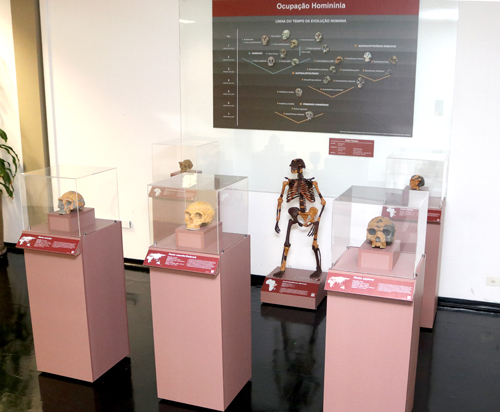IEA displays fossil replicas in an installation on human evolution
 |
|---|
| Curated by paleoanthropologist Walter Neves, installation was opened to the public | Photo: Nelson Niero Neto / IEA-USP |
On February 27, the IEA inaugurated the installation "Hominine Occupation" on the human evolutionary process. It is open to the public, and has replicas of six hominins and a panel with a timeline summarizing the evolution of our species.
The installation was made possible with resources from the Institute and its organizer and curator is paleoanthropologist Walter Neves, a professor retired from USP's Institute of Biosciences (IB). The pieces have been produced by paleoartist Rogério Corrêa de Souza.
Despite the existence of hundreds of discovered hominins, the six selected ones are considered the most iconic in the evolutionary timeline, according to Neves: Sahelanthropus tchadensis (who lived between 6 and 7 million years ago), Australopithecus afarensis (between 3.9 and 2.9 million years ago), Homo habilis (between 2.6 and 1.5 million years ago), Homo erectus (between 1.89 million and 100 thousand years ago), Homo neanderthalensis (between 200 thousand and 30 thousand years ago), and Homo sapiens (who appeared 200 thousand years ago).
The full-body replica of Australopithecus afarensis is based on the fossil known as Lucy, found in Ethiopia in 1974 and considered the most famous one of a human ancestor. According to the dating process, Lucy lived 3.2 million years ago and measured about 1.10 m, walking upright like humans today, but with body proportions similar to those of a chimpanzee.
Among all the replicas, the oldest human ancestor is Sahelanthropus tchadensis, who lived between 6 and 7 million years ago. The fossil was found in Chad in 2001.
A QR Code next to each replica gives access to further information on the displayed ancestors. The individual characteristics are addressed in video lessons with Professor Neves. The content (in Portuguese) is available on YouTube.
The panel presenting the evolutionary timeline is an adaptation of the image "Hominid Evolutionary Tree," from the Natural History Museum in London, and summarizes 7 million years of evolution.
Scientific divulgation
Walter Neves is one of the leading names in the areas of evolutionary biology, evolutionary anthropology, and archeology in Brazil. During his studies of human origins in South America, he was responsible for the analysis of "Luzia," the oldest human skeleton (11 thousand years old) discovered in the subcontinent until now. The fossil's name, given by Neves, was inspired by Lucy.
Since the beginning of his academic career, over 40 years ago, Neves has been striving to promote scientific divulgation, and the dissemination of evolutionary theory and the human evolutionary process to the general public. This is the first time the researcher has managed to create an exhibition like this at USP. Throughout his career, he has gathered a collection of replicas sufficient to carry out a great exhibition to review the entire human evolutionary timeline.
Currently, Neves is concerned with what he sees as an exponential growth in the acceptance of the creationist theory among Brazilian government agencies, such as the Ministry of Education. "Evangelical representation in the National Congress has articulated this movement, which can culminate in the mandatory teaching of creationism in public schools," he says.
"Research institutions, universities, and museums are at a standstill in this regard. A reaction is missing. We need to take advantage of all the opportunities and spaces to publicize evolutionism," says the professor, who highlights "IEA's sensitivity in realizing that this is a hot topic."
For Neves, the University of São Paulo and all Brazilian capitals should have a permanent exhibition on human evolution. "Thus, people can be introduced to what science has to say on the subject. From there, choosing creationism or evolutionism is a personal decision. But there must be this visibility to science."
